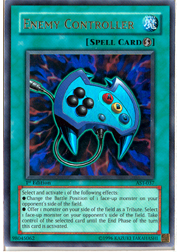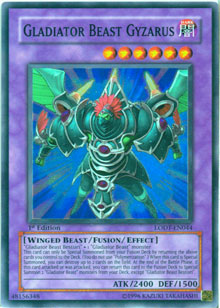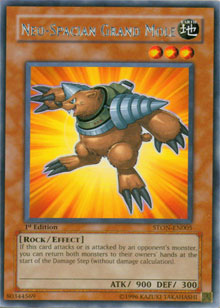 Some months things just move quicker than normal, and considering that we’ve had three major premier tournaments in the past three weeks, this is definitely one of those times. The competitive metagame in North America is shifting in subtle ways at a very quick pace, but one card that just keeps getting better is the card I want to discuss today: Enemy Controller.
Some months things just move quicker than normal, and considering that we’ve had three major premier tournaments in the past three weeks, this is definitely one of those times. The competitive metagame in North America is shifting in subtle ways at a very quick pace, but one card that just keeps getting better is the card I want to discuss today: Enemy Controller.
Enemy Controller first appeared on my radar after Jerome made Day 2 with Counter Fairies. If you remember the coverage from Shonen Jump Championship Saint Louis, you’ll remember that Jerome’s feature match against Shane Scurry was basically lost to one card: Spirit Reaper. At the time, Jerome had prioritized Book of Moon over Enemy Controller. I’d had the pleasure of testing with him and had agreed that Book was the way to go. But the swap of Book for Controller would have provided strong answers to Reaper—one of the deck’s few Achilles’ heels—and it turned out to be a good pick in the long run. From there, I started noticing just how great Enemy Controller was in any metagame dominated by Gladiator Beasts.
Fast forward to this past weekend in Philadelphia {link: http://metagame.com/yugioh.aspx?tabid=61&EventId=201}: both Bellido brothers main-decked a single copy of Enemy Controller in their Gladiator Beast builds, and they pulled off some impressive moves with it as Day 1 wore on. I wound up writing about Enemy Controller in an early round Tech Update on Saturday, but as I watched feature match after feature match, the full strength of the card really became apparent. I wanted to take more time to discuss this incredibly versatile card and what it can do in the current format. I’ll start with the bases I already covered on Saturday.
It Shuts Down Tag-Team Antics
Enemy Controller is a nightmare to play against if you’re piloting Gladiator Beasts. It beats you down in three ways (both of which are central to your strategy), and as a quick-play spell it’s difficult to anticipate. It can hit at virtually any time with little warning, and as more duelists get better and better with Gladiator Beasts, the play patterns for the deck become increasingly standardized and more predictable. That makes it easier to pull apart opposing plays with Controller.
The first way to do this is to simply stop attacks. Gladiator Beasts can’t tag out if their attacks never finish, so Enemy Controller can block an attack and cut short your opponent’s  attempted plays. That leaves high-ATK Gladiators with low DEF (like Gladiator Beast Laquari and Gladiator Beast Darius) very vulnerable to counterattack as well.
attempted plays. That leaves high-ATK Gladiators with low DEF (like Gladiator Beast Laquari and Gladiator Beast Darius) very vulnerable to counterattack as well.
Alternatively, Enemy Controller’s second effect can be chained to the activation of Test Tiger’s effect, stealing away the Tiger’s intended target. Swipe the Gladiator Beast your opponent had planned to tag out, and he or she won’t be able to send it back to the deck, wasting the Tiger. You’ll need to tribute a monster and give up Controller to make that play, but your opponent loses the Tiger immediately, and in many cases a follow-up attack will cost him or her a second card to balance the two you expended. Even if you can’t manage that, you’ll at least stop whatever your opponent had planned, which can often mean the difference between a continued duel and immediate defeat. It’s an especially good move if you can leave something small, like Murmillo or Secutor, in vulnerable attack mode.
There’s a third way to stymie the Gladiator Beasts on a regular basis with Enemy Controller, but it’s tied into my next topic. Simply put . . .
It Stops the Big Guys
I think it’s fair to say that aside from support picks like Elemental Hero Stratos, the three most feared monsters in the game are Gladiator Beast Gyzarus, Dark Armed Dragon, and Judgment Dragon. As the headliner cards for three of the format’s top decks, each is a  special summon, and each has a powerful destruction effect usually played when the monster is summoned. All three tend to make big, often game-winning attacks to follow up too, and that’s where Enemy Controller comes in handy.
special summon, and each has a powerful destruction effect usually played when the monster is summoned. All three tend to make big, often game-winning attacks to follow up too, and that’s where Enemy Controller comes in handy.
Since Controller is chainable, it can be played in response to the destructive effects of any of these three monsters. When you activate Controller, protecting yourself and shutting down your opponent is as easy as targeting whatever big threat just hit the field: you’ll save yourself as much as 3000 damage, and in the case of Gladiator Beasts, you’ll keep Gyzarus from tagging out. With its vulnerable 1500 DEF, it’s a sitting duck, and you’ll stop your opponent from tagging right out into Gladiator Beast Heraklinos. That keeps the opponent consolidated into a single monster and lets you effectively take out two of his or her cards in one shot, either through battle or a removal effect like Smashing Ground.
That’s Great, but You Already Said That
I used fewer words, but yes, a lot of the previous points were already explored in this past weekend’s tournament coverage. However, there are a number of factors I didn’t address because the full gravity of their importance wasn’t obvious when I was under time constraints. For instance, though I may have touched on it at some point over the weekend, the incredible ability to create attack opportunities is often worth playing Enemy Controller completely on its own.
As I alluded to when I mentioned the Murmillo/Secutor and Gyzarus plays, Controller can turn weak monsters to their weakest battle position. Hammer damage through monsters that are low on ATK by turning them to attack mode, or shift big hitters to defense mode and make them more manageable. You can steal a monster to clear it out of the way, while also  turning it into a viable attacker at the same time. You can even swipe a monster in the wrong position that your opponent would obviously like to shift before that player does so on his or her own turn. When you enter your turn, that monster will be in the position that favors your interests.
turning it into a viable attacker at the same time. You can even swipe a monster in the wrong position that your opponent would obviously like to shift before that player does so on his or her own turn. When you enter your turn, that monster will be in the position that favors your interests.
Again, this is basic, but you really need to consider just how many monsters in top-level competition right now are vulnerable to this type of move. Virtually all the Gladiator Beasts are weak in at least one battle position, with the two I’ve already mentioned being extremely easy to press damage through. The face-up Neo-Spacian Grand Mole play is gaining a lot of steam as a defensive maneuver, but sweeping it to your side of the field shuts it down completely. Destiny Hero - Malicious can go from free chump blocker to damage magnet, Limit Reverse can be exploited to easily destroy the monster it’s attached to, and you can play around a pesky Destiny Hero - Fear Monger and avoid attacking it. Chain Enemy Controller to Lyla, Lightsworn Sorceress’s effect to keep her from destroying more important spell or trap cards and leave her vulnerable. Turn a defense-mode Ryko, Lightsworn Hunter to attack mode, chain to Celestia, Lightsworn Angel’s effect to abuse her sub-par 200 DEF, or make Wulf, Lightsworn Beast into a furry snack for Gladiator Beast Secutor. The list could go on and on.
When you really need to force damage, Enemy Controller is an incredible option. It opens up attack opportunities that let you poke holes in everything right now save Gadgets or perhaps Six Samurai, and makes otherwise-impossible wins a reality. And few duelists see it coming.
Create Opportunities for Tributes and Effects
Attacks aren’t all that Enemy Controller lets you pull off. By taking your opponent’s monster, you can also open tribute opportunities. You can trade something like a Sheep Token that couldn’t normally be used for a tribute summon for something you can tribute, or just use Enemy Controller as a makeshift Soul Exchange, eliminating an opposing monster and allowing you to make an immediate attack. You can even tribute away monsters that couldn’t be destroyed otherwise. (More on that later.)
The same theory applies to effects that require particular monsters to be expended, namely playing Enemy Controller to take an opposing Gladiator Beast, then attacking and tagging it out. The Gladiator you borrowed will go back to your opponent’s deck, and if you’re playing Gladiators too, you’ll get the special summon (from your own deck). If you couldn’t attack over your opponent’s Gladiator Beast, this is a great way to play around that. At the same time, you could make a direct attack as a result too: something you couldn’t do if you simply opted to play Enemy Controller’s first effect.

Goes Great With Graveyard Effects
It Does the Opposite As Well
As much as Enemy Controller synergizes with so many monsters, it’s also the perfect answer to several others. I stated at the beginning of this discussion that Spirit Reaper’s vulnerability to Enemy Controller was a big reason to play it, and with more and more Gladiator Beast duelists playing Crush Card Virus (and thus Reaper), that continues to be a strong point. But there’s another powerful monster that Enemy Controller is particularly good against: Prime Material Dragon.
Taking down a monster that can’t be destroyed by effects is never easy: cards that can actually deal with Prime Material Dragon have seen a sharp increase in play since the American National Championships, and duelists have resorted to playing cards like Dimensional Prison and Brain Control in decks that normally wouldn’t run them as a result. Enemy Controller fits into the same category—while turning Prime Material to defense mode isn’t particularly useful in most cases (due to its highly respectable 2000 DEF), straight up taking it certainly is. From there, the Dragon can be tributed or used as an attacker itself, and it’ll shield your monsters from destruction for the turn on which you take it. Enemy Controller trumps Brain Control and Dimensional Prison in this regard, since it’s chainable while Prison and Brain are not.
Prime Material Dragon is quickly turning into the deadliest card Monarchs have, and the fact that you can shut it down with a card that packs such high utility is pretty impressive. Utility as a whole is a key strength of Enemy Controller. There are so many ways to play it, and it’s so good in top matchups, that it’s extremely easy to justify in multiples.
I think we’ll see more of Enemy Controller at upcoming Shonen Jump Championships. It’s flexible, you can play it in almost anything, and since it’s been reprinted as a common in Starter and Structure decks three times thus far, it’s super-easy to get your hands on. Try it out for yourself—it’s really an impressive card.
—Jason Grabher-Meyer